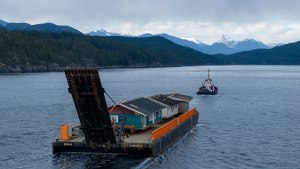To carry water to the turbines at its aluminum smelter in Kitimat, British Columbia, Rio Tinto Alcan (NYSE: RIO) has applied to complete a tunnel to complement an existing one built in the 1950s.
VANCOUVER
Rio Tinto Alcan (NYSE: RIO) has proposed finishing a tunnel that was bored about halfway of its intended distance as part of the Kemano Completion Project, which the provincial government killed in 1995 over environmental concerns.
The proposal, now in its early stages, would involve building a second tunnel to complement an existing one that’s been operating for more than half a century, a company spokesman said.
“We’ve made an application to complete the partially completed second tunnel that we have and connect it to the existing power station,’’ said Paul Henning, Rio Tinto Alcan’s vice-president of B.C. operations.
The proposed second tunnel would connect to existing infrastructure and serve as a backup for the current one, Henning said.
“It’s not new capacity, but a contingency to support the original tunnel which is now close to 60 years old,’’ he said.
Rio Tinto Alcan is pursuing the second tunnel project as its long-awaited US$2.5-billion smelter upgrade moves into high gear in Kitimat.
That project, which will boost the existing aluminum smelter’s capacity by nearly 50 per cent, has been on the drawing board since at least 1997, when Alcan and B.C. reached a settlement over the scrapped Kemano Completion Project that included a commitment for expanded smelter operations.
Rio Tinto Alcan announced a conditional go-ahead for a smelter upgrade in 2006, but global financial woes put the project on the back burner until this year.
The potential case for a second tunnel came into focus as the company considered the lifespan and condition of the current one, Henning said.
That tunnel, which carries water 16 kilometres through a mountain and dumps it over turbines to generate electricity for the Kitimat aluminum smelter, has had two collapses, one in 1958 that resulted in a partial shutdown of water flow through the tunnel, and one in 1961 that put the smelter offline.
Canadian Press










Recent Comments
comments for this post are closed